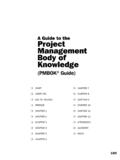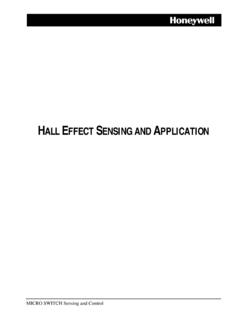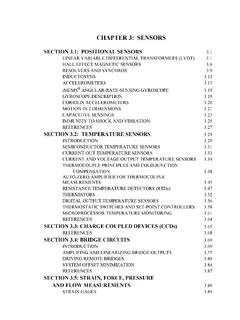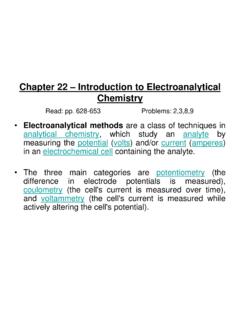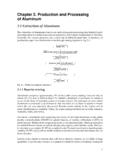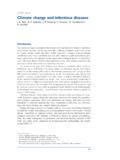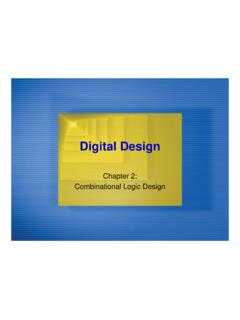Transcription of Chapter 2 Intelligent Agents
1 CS461 Artificial Intelligence Pinar DuyguluSpring 20081 Chapter 2 Intelligent AgentsCS 461 Artificial IntelligencePinar DuyguluBilkent University, Spring 2008 Slides are mostly adapted from AIMACS461 Artificial Intelligence Pinar DuyguluSpring 20082 Outline Agents and environments Rationality PEAS (Performance measure, Environment, Actuators, Sensors) Environment types Agent typesCS461 Artificial Intelligence Pinar DuyguluSpring 20083 Agents An agent is anything that can be viewed as perceiving its environment through sensors and acting upon that environment through actuators Assumption: Every agent can perceive its own actions (but not always the effects)CS461 Artificial Intelligence Pinar DuyguluSpring 20084 Agents Human agent: eyes, ears, and other organs for sensors; hands,legs, mouth, and other body parts for actuators Robotic agent: cameras and infrared range finders for sensors.
2 Various motors for actuators A software agent: Keystrokes, file contents, received network packages as sensors Displays on the screen, files, sent network packets as actuatorsCS461 Artificial Intelligence Pinar DuyguluSpring 20085 Agents and environments Percept: agent s perceptual input at any given instant Percept sequence: complete history of everything the agent has ever perceived An agent s choice of action at any given instant can depend on the entire percept sequence observed to date An agent s behavior is described by the agent function which maps from percept histories to actions:[f: P* A] We can imagine tabulating the agent function that describes any given agent (External characterization) Internally, the agent function will be implemented by an agent program which runs on the physical architecture to produce f agent = architecture + programCS461 Artificial Intelligence Pinar DuyguluSpring 20086 Vacuum-cleaner world Two locations: A and B Percepts: location and contents, , [A,Dirty] Actions: Left, Right, Suck, NoOpOne simple function is : if the current square is dirty then suck, otherwise move to the other [A,Clean][A, Dirty][B,Clean][B,Dirty][A,Clean],[A,Cle an][A,Clean],[A,Dirty].
3 [A,Clean],[ ],[A,Clean][A,Clean],[A,Clean],[A,Clean] ActionsPercept sequenceCS461 Artificial Intelligence Pinar DuyguluSpring 20087 Rational Agents An agent should strive to "do the right thing", based on what it can perceive and the actions it can perform. The right action is the one that will cause the agent to be most successful Performance measure: An objective criterion for success of an agent's behavior , performance measure of a vacuum-cleaner agent could be amount of dirt cleaned up, amount of time taken, amount of electricity consumed, amount of noise generated, etc. As a general rule, it is better to design performance measures according to what one actually wants in the environment. Rather than according to how one thinks the agent should behave (amount of dirt cleaned vs a clean floor) A more suitable measure would reward the agent for having a clean floorCS461 Artificial Intelligence Pinar DuyguluSpring 20088 Rationality What is rational at any given time depends on four things The performance measure that defines the criterion of success The agent s prior knowledge of the environment The actions that the agent can perform The agent s percept sequence to date Rational Agent.
4 For each possible percept sequence, a rational agent should select an action that is expected to maximize its performance measure, given the evidence provided by the percept sequence and whatever built-in knowledge the agent Artificial Intelligence Pinar DuyguluSpring 20089 Vacuum cleaner agent Let s assume the following The performance measure awards one point for each clean square at each time step, over a lifetime of 1000 time steps The geography of the environment is known a priori but the dirt distribution and the initial location of the agent are not. Clean squares stay clean and the sucking cleans the current square. The Left and Right actions move the agent left and right except when this would take the agent outside the environment, in which case the agent remains where it is The only available actions are Left, Right, Suck and NoOp The agent correctly perceives its location and whether that location contains dirt Under these circumstances the agent is rational:its expected performance is at least as high as any other agent sCS461 Artificial Intelligence Pinar DuyguluSpring 200810 Vacuum cleaner agent Same agent would be irrational under different circumstances once all dirt is cleaned up it will oscillate needlessly back and forth.
5 If the performance measure includes a penalty of one point for each movement left or right, the agent will fare poorly. A better agent for this case would do nothing once it is sure that all the squares are clean. If the clean squares can become dirty again, the agent should occasionally check and clean them if needed. If the geography of the environment is unknown the agent will need to explore it rather than stick to squares A and BCS461 Artificial Intelligence Pinar DuyguluSpring 200811 Rational Agents Rationality is distinct from omniscience (all-knowing with infinite knowledge) Rationality maximizes expected performance while perfection maximizes actual performance Agents can perform actions in order to modify future percepts so as to obtain useful information (information gathering, exploration) An agent is autonomous if its behavior is determined by its own experience (with ability to learn and adapt)CS461 Artificial Intelligence Pinar DuyguluSpring 200812 Specifying the task environment (PEAS) PEAS.
6 Performance measure, Environment, Actuators, Sensors In designing an agent, the first step must always be to specify the task environment (PEAS) as fully as possibleCS461 Artificial Intelligence Pinar DuyguluSpring 200813 PEAS for an automated taxi driver Performance measure: Safe, fast, legal, comfortable trip, maximize profits Environment: Roads, other traffic, pedestrians, customers Actuators: Steering wheel, accelerator, brake, signal, horn Sensors: Cameras, sonar, speedometer, GPS, odometer, engine sensors, keyboardCS461 Artificial Intelligence Pinar DuyguluSpring 200814 PEAS for a medical diagnosis system Performance measure: Healthy patient, minimize costs, lawsuits Environment: Patient, hospital, staff Actuators: Screen display (questions, tests, diagnoses, treatments, referrals) Sensors: Keyboard (entry of symptoms, findings, patient's answers)CS461 Artificial Intelligence Pinar DuyguluSpring 200815 PEAS for a satellite image analysis system Performance measure: correct image categorization Environment: downlink from orbiting satellite Actuators: display categorization of scene Sensors: color pixel arraysCS461 Artificial Intelligence Pinar DuyguluSpring 200816 PEAS for a part-picking robot Performance measure: Percentage of parts in correct bins Environment: Conveyor belt with parts, bins Actuators: Jointed arm and hand Sensors: Camera, joint angle sensorsCS461 Artificial Intelligence Pinar DuyguluSpring 200817 PEAS for a refinery controller Performance measure: maximize purity, yield, safety Environment: refinery, operators Actuators: valves, pumps, heaters, displays Sensors.
7 Temperature, pressure, chemical sensorsCS461 Artificial Intelligence Pinar DuyguluSpring 200818 PEAS for Interactive English tutor Performance measure: Maximize student's score on test Environment: Set of students Actuators: Screen display (exercises, suggestions, corrections) Sensors: KeyboardCS461 Artificial Intelligence Pinar DuyguluSpring 200819 Environment types Fully observable vs. partially observable Deterministic vs. stochastic Episodic vs. sequential Static vs. dynamic Discrete vs. continuous Single agent vs. multiagentCS461 Artificial Intelligence Pinar DuyguluSpring 200820 Environment typesFully observable vs. partially observable: An environment is fully observable if an agent's sensors give it access to the complete state of the environment at each point in time. Fully observable environments are convenient, because the agent need not maintain any internal state to keep track of the world An environment might be partially observable because of noisy and inaccurate sensors or because parts of the state are simply missing from the sensor data Examples: vacuum cleaner with local dirt sensor , taxi driverCS461 Artificial Intelligence Pinar DuyguluSpring 200821 Environment typesDeterministic vs.
8 Stochastic: The environment is deterministic if the next state of the environment is completely determined by the current state and the action executed by the agent. In principle, an agent need not worry about uncertainty in a fully observable, deterministic environment If the environment is partially observable then it could appear to be stochastic Examples: Vacuum world is deterministic while taxi driver is not If the environment is deterministic except for the actions of other Agents , then the environment is strategicCS461 Artificial Intelligence Pinar DuyguluSpring 200822 Environment typesEpisodic vs. sequential: In episodic environments, the agent's experience is divided into atomic "episodes" (each episode consists of the agent perceiving and then performing a single action), and the choice of action in each episode depends only on the episode itself. Examples: classification tasks In sequential environments, the current decision could affect all future decisions Examples: chess and taxi driverCS461 Artificial Intelligence Pinar DuyguluSpring 200823 Environment typesStatic vs.
9 Dynamic: The environment is unchanged while an agent is deliberating. Static environments are easy to deal with because the agent need not keep looking at the world while it is deciding on the action or need it worry about the passage of time Dynamic environments continuously ask the agent what it wants to do The environment is semi-dynamic if the environment itself does not change with the passage of time but the agent's performance score does Examples: taxi driving is dynamic, chess when played with a clock is semi-dynamic, crossword puzzles are staticCS461 Artificial Intelligence Pinar DuyguluSpring 200824 Environment typesDiscrete vs. continuous: A limited number of distinct, clearly defined states, percepts and actions. Examples: Chess has finite number of discrete states, and has discrete set of percepts and actions. Taxi driving has continuous states, and actionsCS461 Artificial Intelligence Pinar DuyguluSpring 200825 Environment typesSingle agent vs.
10 Multiagent: An agent operating by itself in an environment is single agent Examples: Crossword is a single agent while chess is two- Agents Question: Does an agent A have to treat an object B as an agent or can it be treated as a stochastically behaving object Whether B's behaviour is best described by as maximizing a performance measure whose value depends on agent's A behaviour Examples: chess is a competitive multiagent environment while taxi driving is a partially cooperative multiagent environmentCS461 Artificial Intelligence Pinar DuyguluSpring 200826 Environment types The environment type largely determines the agent design The real world is (of course) partially observable, stochastic, sequential, dynamic, continuous, multi-agentSingleMultiContinuousDiscrete DynamicDynamicSequentialSequentialStocha sticStochasticPartiallyPartiallyRefinery controllerInteractive English TutorSingleSingleContinuousContinuousSem iDynamicEpisodicEpisodicDeterministicSto chasticFullyPartiallyImage AnalysisPart-picking robotMultiSingleContinuousContinuousDyna micDynamicSequentialSequentialStochastic StochasticPartiallyPartiallyTaxi drivingMedical DiagnosisMultiMultiDiscreteDiscreteStati cStaticSequentialSequentialStochasticSto chasticPartiallyFullyPokerBackgammonSing leMultiDiscreteDiscreteStaticSemiSequent ialSequentialDeterministicStrategicFully FullyCrossword puzzleChess with a clockAgentsDiscreteStaticEpisodicDetermi nisticObservableTask EnvironmentCS461 Artificial Intelligence Pinar DuyguluSpring 200827 Agent functions and programs An agent is completely specified by the agent function mapping percept sequences to
